The Amanita mushrooms are a really important mushroom family to learn, it contains some of the most notorious and best-known mushrooms that can be found in British woodlands.
There are some good edible Amanitas but it’s also the family that contains some of the world’s most poisonous mushrooms such as the Death Cap (Amanita Phalloides,) and the Destroying Angel (Amanita Virosa).
On our foraging courses, I typically advise those starting their journey into mushroom foraging against eating them until they are more knowledgeable.
There are about 50 Amanita species in the UK but only around 15 are common, of these 15, 5 are classed as being deadly poisonous!
Immature specimens may not have all of the features present so it’s always good to find more than one example to help with identification and I’d always use a knife or small trowel to remove the whole mushroom so that you can have a look at the basal features.
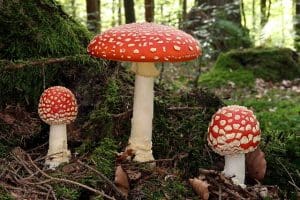
Listen to our Amantia Mushrooms Podcast
It’s generated by ai from our database, but our team have found it really useful so we want to share it.
The Checklist when Foraging Amanita Mushrooms
If you are new to foraging, I’d generally tell you to avoid them all and I’d be running through this checklist in my mind;
- Does it have a cap with a central stem and gill?
- Does it have true gills or gills that are more like ridges?
- Are you near trees? Or a hedgerow at least?
- Are the gills white/off white?
- Are there lot of intermediate gills (i.e. gills that don’t go all of the way from cap edge to stem)?
- Does it have a bulbous base or egg-sack?
- Are there any scales or patches on the cap?
- Is there a ring or skirt on the stem?
- Does it leave a white spore print?
If you’ve answered yes to most of those questions you are probably looking at a member of the Amanita family, if so you’re best to take some photos and move on.
General Rules of the Aminita Family
In general, the key features of the Amanita family are:
- They are all mycorrhizal with trees, so you will find them growing on soil near the base of trees or hedgerows.
- They tend to either have a volva structure at the end of the stem or a bulbous/swollen base.
- They tend to have white/off-white gills that are crowded and free from the stem.
- They all have white spores.
- The caps are easily separated from the stems.
- Many have fragments of their universal veil on the caps. Showing as either warts or irregular patches.
- Most have a ring or skirt on the stem, these are remnants of the partial veil that covers the gills when the mushroom is immature.
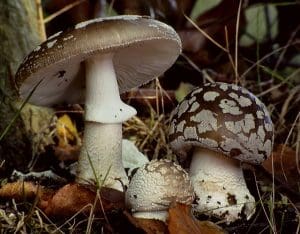
What if they don’t have a ring on the stem
There are some Ringless Amanita species that are colloquially called the ‘Grisettes’. Telling the Grisettes apart from one another can sometimes be difficult, they are all edible when cooked so are a good group to learn.
In general, they differ from other Amanitas as they lack a skirt or ring on their stems. The other key features are:
- They tend to be medium to large mushrooms with distinct caps, gills and stems.
- The caps are generally smooth and free from any volval remains and they have striations along the edge.
- Their gills are white to off white, free and crowded.
- Their stems lack a ring but may be smooth or have a snakeskin pattern,
- The stems terminate in a sack-like volva structure.
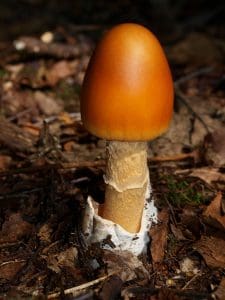
Potential Lookalikes to the Amanita Mushrooms
Other mushrooms that may look like Amanitas
The Puffballs
The Amanitas all develop from a volva, this egg-like structure that’s often slightly below ground, at this stage they can be confused with Puffballs. Always cut your Puffballs in half to make sure that there isn’t a little mushroom inside, the inside of a Puffball should be pure white with no discolouration.
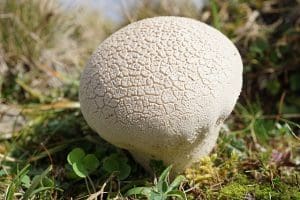
The Agaricus family
If you pick a very young Agaric before its cap has fully opened they can look like an Amanita. Check the gills, Amanitas all have white gills, Agarics have off-white to pink gills when they are young.
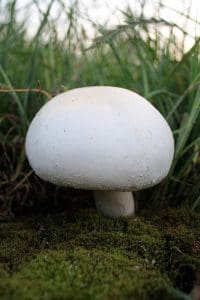
The Parasols
There are a number of physical similarities between these two families, they both can have bulbous bases to their stems, they both leave a white spore print, they can both have remains of their universal veil on the caps, they can both have a skirt on their stems and they both have whitish gills.
The key differences are the scales on the caps of Parasols cannot be brushed or knocked off like they can be on Amanitas, also check the skirt, on a parasol, this should easily move up and down the stem without breaking.
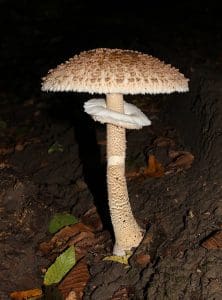
The Earthballs
Again like the Puffballs, young Amanitas can be confused with members of the Earthball family. It’s important to cut any you are unsure of in half, the centre of Earthballs will be fully white or starting to look like dark purple marble – the amanitas will look like a baby mushroom cap in a sack ready to open up.
Learning the key features of the family is really important if only so you can avoid them. The edible species are quite tasty but I’ll leave it to you to decide whether they are worth the risk.
If you are intending to collect them for the kitchen you do want to be 100% certain of the ID and never eat any members of this family raw.
If you’re new to foraging I’d tell you to remember the old saying “Never eat an Amanita”
The most common Amanita Mushrooms found in the UK
Fly Agaric (Amanita Muscaria) instantly recognisable, the ‘Father Christmas’ mushroom, has a massive history in folk law due to its hallucinogenic properties,

Death Cap (Amanita Phalloides) one of the world’s most toxic mushrooms, not very common but when conditions are right they do become more frequent.
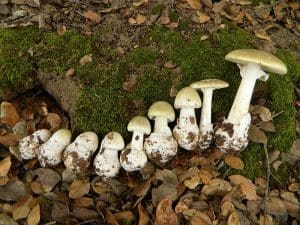
False Deathcap (Amanita Citrina) it contains the same toxins as the Deathcap but in lower concentrations, probably not deadly but still one to avoid.
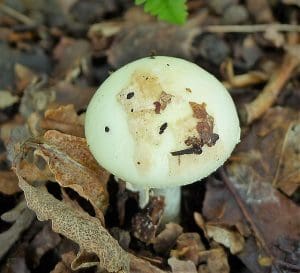
The Panther Cap (Amanita Pantherina) contains the psychoactive compounds ibotenic acid, muscimol, muscazone and muscarine so should be considered toxic. Some field guides list it as deadly.
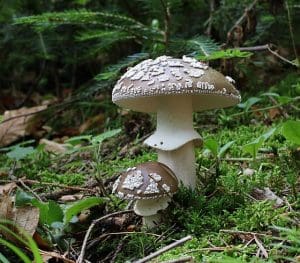
The Destroying Angel (Amanita Virosa) just as deadly as the Death Cap.
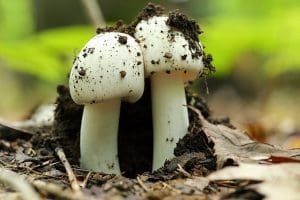
The Solitary Amanita (Amanita Echinocephala) very rare and protected by law in the UK.
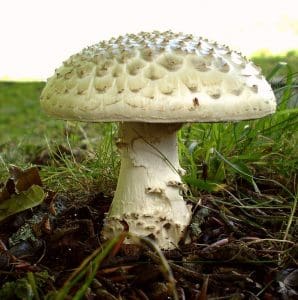
The Jewelled Amanita (Amanita Gemmata) closely related to the Fly Agaric and contains the same toxins.
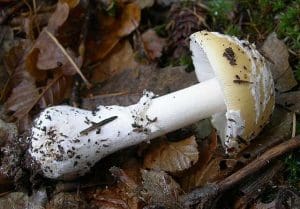
The Grey Spotted Amanita (Amanita Excelsa) an edible member of the family but because of the risk of misidentification not recommended for beginners.
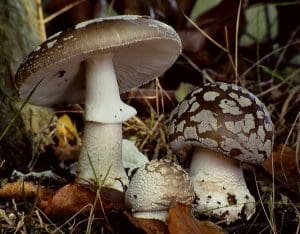
The Grey Veiled (Amanita Porphyria) classed as inedible, it may contain dangerous toxins.
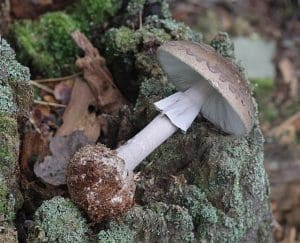
The Grisette (Amanita Vaginata) an edible member of the family, they can be confused with toxic species so care needs to be taken.
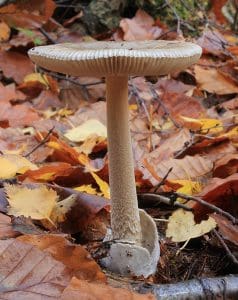
The Blusher (Amanita Rubescens) a good edible mushroom but it must be cooked thoroughly before consumption.
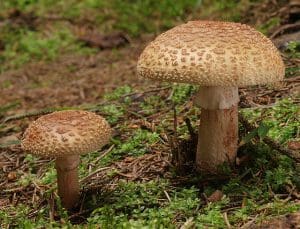
Snakeskin Grisette (Amanita Ceciliae) found in mixed woodlands throughout the UK. Lacks the ring on the stem and has striation along the cap margin. Edible.
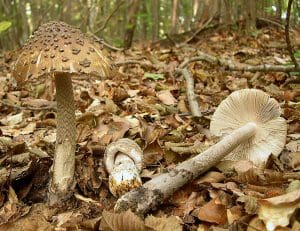
Olive Amanita (Amanita Submembranacea) quite a rare mushroom in the UK and there is little information about edibility, some sources class it as suspect others as edible so best avoided.
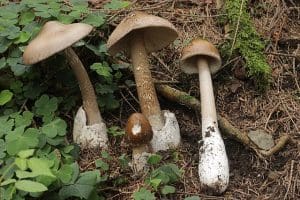
Orange Grisette (Amanita Crocea) Pretty common in the UK, again lacks a ring and has obvious striations on the cap margin.
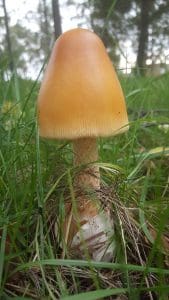
Tawny Grisette (Amanita Fulva) very similar in appearance to the Snakeskin Grisette but this one lacks the zig-zag pattern on the stem. Edible
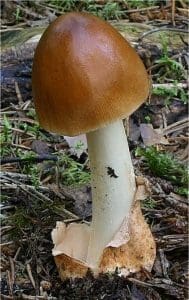






Leave a Reply
You must be logged in to post a comment.